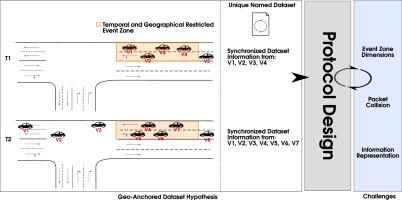Vehicular-NDN: Geo-Anchored Datasets
IF 6.2
2区 计算机科学
Q1 COMPUTER SCIENCE, THEORY & METHODS
Future Generation Computer Systems-The International Journal of Escience
Pub Date : 2025-09-10
DOI:10.1016/j.future.2025.108124
引用次数: 0
Abstract
In this paper, we introduce the concept of Geo-Anchored Datasets (GADs) – named datasets constructed from geographical areas where vehicles tend to aggregate due to traffic rules and density, leveraging Named Data Networking (NDN) applied to Vehicular Ad-Hoc Networks (VANETs). These datasets include information from vehicles that pass through the defined area, remain valid for a controlled period, and, within that brief time, require at least one vehicle to be present in the area at any given moment to retain the information. The focus of this work is to present a mechanism for fast and collision-efficient information synchronization under geographical and temporal restrictions. The proposed State Vector Push Protocol (SVPP) creates Geo-Anchored Datasets using an epidemic push-based model and the state vector technique. We also propose two scheduling mechanisms to mitigate the effects of the resulting broadcast storm by dynamically adjusting transmission delays based on vehicle density, reducing collision occurrences. In our most demanding scenario – 112 vehicles in a 4 lane 140m static segment – SVPP achieves under 10 % packet loss, sub-second convergence, and 1 Mbit/s throughput, showing high efficiency even under extreme conditions.

vehicle - ndn:地理锚定数据集
在本文中,我们介绍了地理锚定数据集(GADs)的概念——利用应用于车辆自组织网络(VANETs)的命名数据网络(NDN),从交通规则和密度导致车辆聚集的地理区域构建命名数据集。这些数据集包括来自通过指定区域的车辆的信息,在一段受控时间内保持有效,并且在这段短暂的时间内,要求在任何给定时刻至少有一辆车辆出现在该区域以保留信息。本工作的重点是提出一种在地理和时间限制下的快速、冲突高效的信息同步机制。提出的状态向量推送协议(SVPP)使用基于流行病推送的模型和状态向量技术创建地理锚定数据集。我们还提出了两种调度机制,通过基于车辆密度动态调整传输延迟来减轻由此产生的广播风暴的影响,从而减少碰撞事件的发生。在我们最苛刻的情况下——112辆车在4车道140米的静态路段上行驶——SVPP实现了低于10%的数据包丢失、亚秒级收敛和1 Mbit/s的吞吐量,即使在极端条件下也显示出高效率。
本文章由计算机程序翻译,如有差异,请以英文原文为准。
求助全文
约1分钟内获得全文
求助全文
来源期刊
CiteScore
19.90
自引率
2.70%
发文量
376
审稿时长
10.6 months
期刊介绍:
Computing infrastructures and systems are constantly evolving, resulting in increasingly complex and collaborative scientific applications. To cope with these advancements, there is a growing need for collaborative tools that can effectively map, control, and execute these applications.
Furthermore, with the explosion of Big Data, there is a requirement for innovative methods and infrastructures to collect, analyze, and derive meaningful insights from the vast amount of data generated. This necessitates the integration of computational and storage capabilities, databases, sensors, and human collaboration.
Future Generation Computer Systems aims to pioneer advancements in distributed systems, collaborative environments, high-performance computing, and Big Data analytics. It strives to stay at the forefront of developments in grids, clouds, and the Internet of Things (IoT) to effectively address the challenges posed by these wide-area, fully distributed sensing and computing systems.

 求助内容:
求助内容: 应助结果提醒方式:
应助结果提醒方式:


